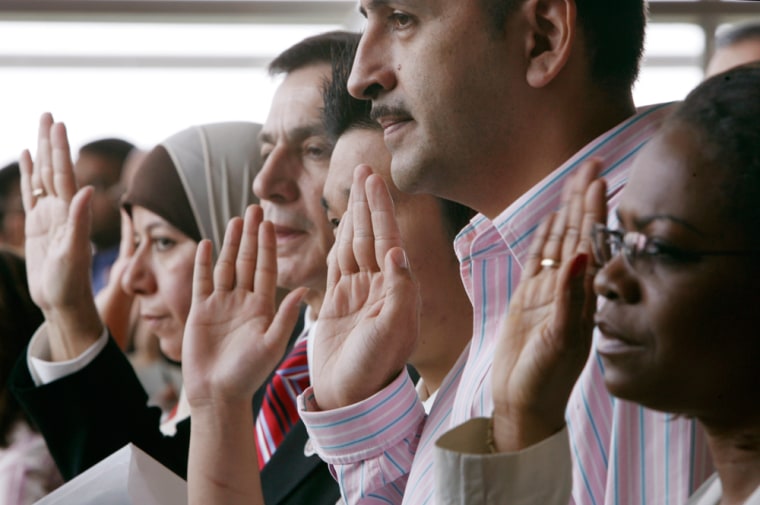The wave of immigrants entering the United States slowed dramatically last year as the economy faltered and the government stepped up enforcement of immigration laws.
The nation added about a half million immigrants in 2007, down from more than 1.8 million the year before, according to estimates being released Tuesday by the Census Bureau.
"The U.S. is still a beacon for many people who want to come here for all kinds of reasons," said William Frey, a demographer at the Brookings Institution who analyzed the numbers. "But what this shows is that the economy plays a big part in it."
The U.S. has added an average of about a million immigrants a year since 1990, including those in the country legally and illegally.
At more than 38 million, the number of immigrants in the U.S. is now at an all-time high. Immigrants made up 12.6 percent of the population in 2007, the largest share since 1920, when the U.S. was nearing the end of its last immigration boom, one that brought millions of people from Europe to the United States.
That wave of immigrants ended with the Great Depression and the onset of World War II.
Looking for jobs
The immigration figures released Tuesday were from the 2007 American Community Survey, the government's annual survey of about 3 million households. The survey, which is replacing the long form from the 10-year census, yields reams of demographic, social and economic data about the nation.
Because the estimates come from a survey, each includes a margin of sampling error that makes year-to-year comparisons inexact. Annual immigration changes for many states and cities were within the margins of error, but the national trend was statistically significant: The nation's immigration boom slowed substantially in 2007.
Fourteen states showed declines in the estimated number of immigrants from 2006 to 2007, including New Jersey, New Mexico, Vermont and South Dakota. Several major cities also posted decreases, including Atlanta, Las Vegas and Oakland, Calif.
Other cities continued to show gains, including Phoenix, Boston and Denver.
"Immigrants have always come to the United States for jobs, but before they went to big immigration magnets to be with family or other immigrants," Frey said. "Now the geography of where these people move is much more tied to the economy than ever before."
Much of the nation experienced a housing boom in the first half of the decade, providing jobs that attracted immigrants. The housing bubble burst last year, sending housing markets tumbling and contributing to a slumping economy that some economists believe is in recession.
The Census Bureau's' estimates for immigrants include those in the country legally and illegally because the agency does not ask about legal status. Government and private estimates put the number of illegal immigrants in the U.S. at about 12 million.
A little more than half of U.S. immigrants are from Latin America and about a quarter are from Asia. About 13 percent are from Europe and 4 percent from Africa.
The latest immigration boom has sparked political and social turmoil in many communities unaccustomed to large influxes of foreigners. About one in five U.S. residents spoke a language other than English at home in 2007, about the same share as a year before.
Immigration reform
The issue, however, has been muted in this year's presidential election in part because both Republican John McCain and Democrat Barack Obama support comprehensive immigration packages that include increased enforcement and an eventual path to citizenship for many illegal immigrants.
Obama and McCain aren't talking much about immigration reform — at least not in English. Both, however, are running Spanish-language TV ads accusing the other of derailing comprehensive immigration packages supported by many Hispanics.
Voters say other issues are more important to them than immigration policy, including the economy, gas prices and education, according to the latest AP-Yahoo News poll.
In many communities, though, immigration is an important issue.
Federal agents started conducting more high-profile immigration raids the past several years. The effects on local immigration levels have been mixed.
For example, a leather goods manufacturer in New Bedford, Mass., was raided in March 2007, and the number of immigrants living there dropped for the year. At the same time number of immigrants in Boston, about 50 miles away, jumped.
A temporary employment agency in Baltimore was raided in March 2007, and the number of immigrants in the city dropped slightly for the year. But a meatpacking plant in Greeley, Colo., was raided in late 2006 and the number of immigrants increased in 2007.
Some communities have tried to get tough on illegal immigration with local ordinances.
In Northern Virginia's Prince William County, officials debated a crackdown for months before directing local police to check the immigration status of everyone they arrest. The county experienced a small drop the number of immigrants last year despite overall population gains.
"In our county there is a tremendous amount of fear," said Nancy Lyall, legal coordinator for Mexicans Without Borders, an immigrant advocacy group. "The people who can leave Prince William County have."
